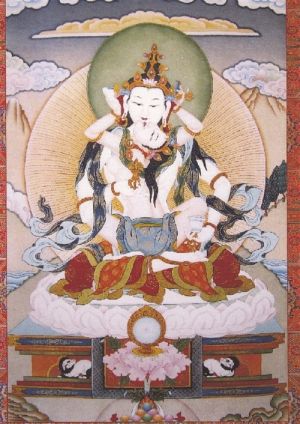Teachers in Enlightenment: Traditions in Tibetan Buddhism
There were there is no Guru
Not even the name of Buddha is heard.
The Buddas of a thousand eons
Depend on the Guru for their appearance.
The fact is that they are His manifestations.
–Naropa (11th-century Buddhist adept and scholar)
It all began with a teacher. The religion we recognize as Buddhism was born in the sixth century BCE from the decision of the historical Buddha Shakyamuni to teach his philosophy and methods for achieving enlightenment to others. Over time, Buddhism traveled
and its practices evolved, but it never lost its connection to the original teacher, Shakyamuni. This connection is made live through the transmission of Buddhist knowledge and practices through generations of teachers, known as gurus, or as lamas — high-ranking monastic teachers in Tibet, and it is a major subject of Buddhist art.
The exhibition Teachers of Enlightenment: Traditions in Tibetan Buddhism at The Nelson-Atkins Museum of Art explores the role of the teacher in Tibetan Buddhism, and how this role is expressed in Tibetan art. This focused presentation features a variety of art forms, including metal sculptures created for altars and hanging, scroll-mounted paintings, known as thangkas, made to adorn temple
halls, and a selection of ritual objects. The exhibition concept was developed by Isabel Vargas, a Mellon Undergraduate Curatorial Fellow at the museum and in consultation with the Rime Buddhist Center in Kansas City. A key focus of the exhibition is to highlight the especially critical function that teachers play in Buddhism in Tibet, which continues to this day wherever Tibetan Buddhism is practiced, including right here in Kansas City.
Teachers of Enlightenment is organized around artworks that depict three key teachers venerated in Tibet: Shakyamuni, the historical Buddha, Padmasambhava — known as Guru Rimpoche “Precious Teacher” and as the “Second Buddha” — who helped establish Buddhism in Tibet, and Tsongkhapa—known as Je Rimpoche “Precious Lord” — who founded the Gelugpa School of Buddhism and taught the first Dalai Lama. These works of art serve multiple functions: as portraits of teachers, as a reminder of their biographies and teachings, and as points of focus for meditations and ritual practices. Moreover, these teachers serve as role models. They represent spiritual attainments and qualities that practitioners want to develop within themselves, and their life stories demonstrate that those achievements are possible.
The images of these enlightened teachers occupy an interesting place in the history of art, as they navigate a space between portrait and icon. While some Tibetan sculptures of teachers appear more naturalistic in appearance, over time, the depictions of important teachers became stylized, their forms perfected, and each was assigned his (or her) own iconography. For example, Padmasambhava is
usually shown holding a staff and ritual objects also held by Buddhas and deities. Tsongkhapa wears the yellow robe and hat of the Gelugpa Order and is shown holding a book, as he is thought to be a manifestation of Manjushri, the bodhisattva of wisdom. The characteristic features of these teachers are evident in the works in the exhibition. The use of brilliant mineral-based colors
brings the detailed thangka paintings to life. In the paintings, teachers are depicted in their colorful monastic robes, offering teachings and interacting with followers in verdant landscape settings. Metals such as copper and gold are used in the creation of the sculptures of these teachers — precious materials that are considered appropriate to use for depicting embodiments of sacred knowledge.
While depictions of teachers are found throughout Buddhist art, they are especially prevalent in Tibetan art. The reason for this is deeply rooted in the form of Buddhism that was established and further developed in Tibet, Vajrayana, or Tantric Buddhism. In this form of Buddhism, sacred knowledge and practices are revealed through their direct transmission from a teacher to an initiate. For this system to work, the chain of transmission must not be broken.
The importance of the teacher and his pedigree in terms of lineage is so important that it inspired a new category of artwork in Tibet, the Assembly Field or Field of Merit. An Assembly Field is a kind of spiritual family tree. In the densely populated Assembly Field painting in the Nelson-Atkins exhibition, you can trace the lineage of Tsongkhapa back to the bodhisattva Manjushri, and forward through generations of monastic teachers and students that followed him.
Bringing the exhibition up to the present day, Teachers of Enlightenment features video interviews with members of the Rime Buddhist Center, who share what their teacher means to them. The Rime Center will also join the museum in hosting several exhibition-related events throughout the year. Join us at the Nelson-Atkins to explore this fascinating artistic tradition, on view through May 10, 2020.
–Kimberly Masteller, Jeanne McCray Beals Curator of South and Southeast Asian Art
Source
[[1]]
